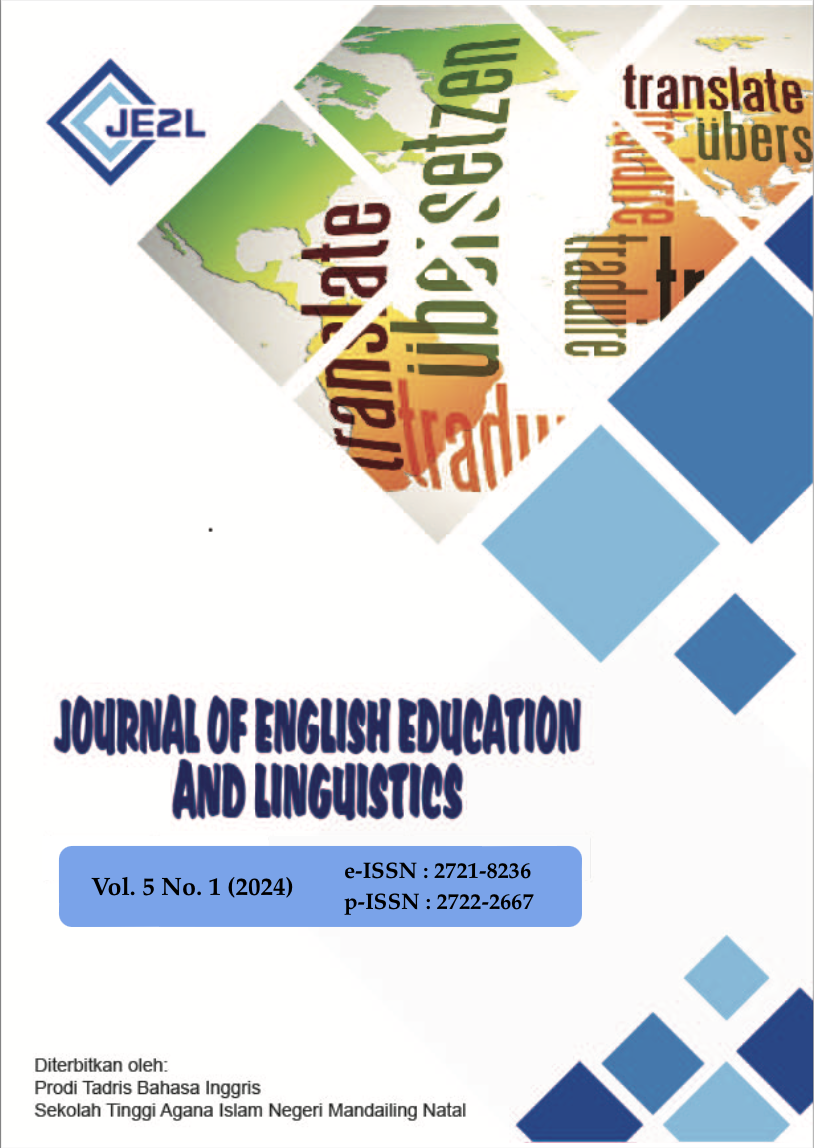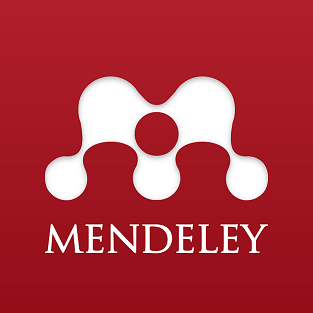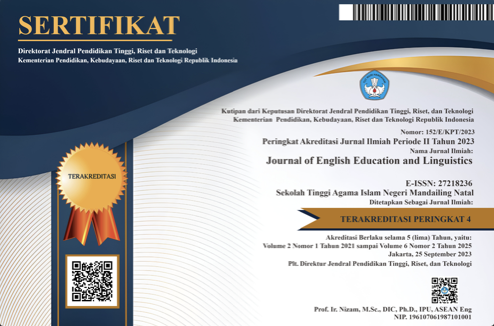DICTION AND IDEOLOGY OF KAESANG PANGAREP'S FIRST SPEECH IN A POLITICAL FORUM
DOI:
https://doi.org/10.56874/jeel.v5i1.1700Keywords:
Critical Discourse Analysis, ideology, diction, language shift, language powerAbstract
This study aims to analyze the diction, language power, and ideology used by Kaesang Pangerep in his first political speech. The analysis was based on Fairclough's CDA theory (1989) and combined with Thomas N. Huckin's model. The research method used was descriptive qualitative, focusing on elaborating paragraphs, sentences, and words. The analysis began with an examination of the entire text, followed by a more detailed analysis of sentences and words. The text was analyzed to understand the contextual interpretation of the relationship between language power and ideology. Additionally, language relevance and style features were analyzed to understand Kaesang Pangarep's diction in his public speech. The results indicated that the connections between language power and ideology were broadly defined through CDA. The study revealed that although there were instances of irrelevant language use, Kaesang Pangarep's speech was directly aimed at the Millennial party. The linguistic ideology in his speech was observed to reflect a legacy role from current political issues, suggesting a shift in the language used to build the ideology, with specific aims and a legacy of current linguistic issues.
References
Aeni, E. S., & Ahmadi, Y. (2021). Analisis kesalahan diksi dan gaya bahasa pidato pejabat pemerintahan berkaitan dengan pandemi covid-19. Semantik, 10(1), 77–86.
Ahlstrand, J. L. (2021). Strategies of ideological polarisation in the online news media: A social actor analysis of Megawati Soekarnoputri. Discourse and Society, 32(1), 64–80. https://doi.org/10.1177/0957926520961634
Alwasilah, A. C. (2011). Pokoknya kualitatif: Dasar-dasar merancang dan melakukan penelitian kualitatif. PT Dunia Pustaka Jaya.
Ardiansah, D. (2015). An analysis of modality in students’ hortatory exposition texts: Systemic functional grammar perspective. Bahasa & Sastra, 15(2), 136–149.
Bavali, M., & Sadighi, F. (2008). Chomsky’s universal grammar and Halliday’s systemic functional linguistics: An appraisal and a compromise. Pan-Pacific Association of Applied Linguistics, 12(1), 11–28.
Creswell, J. C. (2014). Research design: Qualitative, quantitative, and mixed methods approaches (4th ed.). SAGE Publication.
Eggins, S. (2004). An introduction to systemic functional linguistics. Continuum.
Emilia, E. (2014). Introducing functional grammar. Pustaka Jaya.
Fadhillah, A. M., & Rahmadina, K. P. (2021). Interpersonal metafunction analysis of a literary response text in tertiary education. Indonesian Journal of Functional Linguistics, 1(2), 58–71. https://doi.org/10.17509/ijsfl.v1i2.43977
Fairclough, N. (1995). Critical discourse analysis. Longman.
Fairclough, N. (2013). Critical discourse analysis and critical policy studies. Critical Policy Studies, 7(2), 177–197. https://doi.org/10.1080/19460171.2013.798239
Fairclough, N., & Wodak, R. (1997). Critical discourse analysis. in T. van Dijk (Ed.). In Discourse Studies: A Multidisciplinary Introduction (Vol. 2, pp. 258–284). Sage.
Feng, H., & Liu, Y. (2010). Analysis of interpersonal meaning in public speeches - A case study of Obama’s speech. Journal of Language Teaching and Research, 1(6). https://doi.org/10.4304/jltr.1.6.825-829
Halliday, M. A. K., & Matthiessen, C. M. I. M. (2004). An introduction to functional grammar (3rd ed.). Oxford University Press Inc.
Huckin, T. N. (1997). Critical discourse analysis. In Functional approaches to written text: Classroom Application. English Language Program.
Koussouhon, L. A., & Dossoumou, A. M. (2015). Political and ideological commitments: A systemic functional linguistic and critical discourse analysis of President Buhari’s inaugural speech. International Journal of Linguistics and Communication, 3(2), 24–34. https://doi.org/10.15640/ijlc.v3n2a3
Malik, R. S., & Hamied, F. A. (2016). Research methods : A guide for first time researchers (2nd ed.). UPI Press.
Martika, D., Mahayuni, & Azis, A. D. (2022). Critical discourse analysis of Barack Obama speech. Jurnal Ilmiah Profesi Pendidikan, 7(2), 1020–1031. https://doi.org/10.29303/jipp.v7i2c.659
Michira, J. N. (2014). The language of politics: A CDA of the 2013 Kenyan presidential campaign discourse. International Journal of Education and Research, 2(1), 1–18. www.ijern.com
Nashruddin, Alam, F. A., & Harun, A. (2020). Moral values found in linguistic politeness patterns of Bugis society. EDUMASPUL: Jurnal Pendidikan, 3(1), 132–141. https://doi.org/10.33487/edumaspul
Nørgaard, N., Busse, B., & Montoro, R. (2010). Key terms in stylistics. Continuum International Publishing Group.
Obeng, S. G., & Ofori, S. A. (2023). ‘Language’, power and liberty: Discursive constructions of Ghanaian glossolalic speeches. Discourse and Society, 34(3), 357–380. https://doi.org/10.1177/09579265221142444
Padang, S. K., & Sitohang, R. (2018). Linguistic representation of moral value in “Torsatorsa Hombung.” The Episteme Journal of English Literature and Linguistics, 4(2), 1–31.
Rabiah, S. (2012). Language as a tool for communication and cultural reality discloser. 1st International Conference on Media, Communication and Culture, 1–11. https://orcid.org/0000-0002-1690-0025.
Rahmah, A., Kasim, U., & Fitriani, S. S. (2018). Cultural values analysis in English textbook. English Education Journal (EEJ), 9(4), 614–631.
Safitri, G. R., & Utami, S. R. (2021). Pengenalan transitivitas dalam pengajaran bahasa Indonesia. Seminar Nasional Bahasa, Sastra, Dan Seni, 1, 1–9.
Santoso, D., & Aji, A. S. (2021). Critical discourse analysis on Joko Widodo’s speech using Thomas N. Huckin’s theory. Proceedings of the 1st International Conference on Research in Social Sciences and Humanities (ICORSH 2020), 886–894.
Sihite, M. R., Lubis, S. I., & Budi, S. (2021). Discourse analysis on SBY’s international speech text: A study on critical linguistics. Exellence: Journal of English and English Education, 1(2), 23–30.
Sutrisno, B., & Lestari, L. (2021). An analysis of figurative language and moral value in roar song by Katy Perry. Journal of English Language and Literature (JELL), 6(2), 59–70. https://doi.org/10.37110/jell.v6i2.125
Trapes-Lomax, H. (2008). The handbook of applied linguistics (A. Davies & C. Elder, Eds.). Blackwell Publishing Ltd.
Van Dijk, T. A. (1993). Principles of critical discourse analysis. Discourse & Society, 4(2), 249–283.
Weiss, G., & Wodak, R. (2003). Critical discourse analysis: Theory and interdisciplinarity. Palgrave MacMillan.
Downloads
Published
Issue
Section
License
All articles published in the Journal of English Education and Linguistics are licensed under a Creative Commons Attribution-ShareAlike 4.0 International (CC BY-SA) license. This means anyone is free to copy, transform, or redistribute articles for any lawful purpose in any medium, provided they give appropriate attribution to the original author(s) and Journal of English Education and Linguistics, link to the license, indicate if changes were made, and redistribute any derivative work under the same license.
Copyright on articles is retained by the respective author(s) without restrictions. A non-exclusive license is granted to the Journal of English Education and Linguistics to publish the article and identify itself as its original publisher, along with the commercial right to include the article in a hardcopy issue for sale to libraries and individuals.
Although the conditions of the Creative Commons Attribution-ShareAlike 4.0 International (CC BY-SA) license do not apply to authors (as the copyright holder of your article, you have no restrictions on your rights), by submitting to the Journal of English Education and Linguistics, authors recognize the rights of readers and must grant any third party the right to use their articles to the extent provided by the license.

This work is licensed under a Creative Commons Attribution-ShareAlike 4.0 International License.








